Effect of Tool Shoulder Profile on Grain and Texture Development in the Weld Interface Zone of Friction-Stir-Welded Dissimilar AA2024/AA7075 Joints
Abstract
1. Introduction
2. Experimental Procedure
3. Results and Discussion
4. Conclusions
- 1.
- Abundant fine and coarse equiaxial grains are produced in the CIZ and BIZ of dissimilar joints by CCS and THS. Fine equiaxed grains are primarily generated in the interface regions and the region towards the AS, while coarse grains are primarily distributed in the welded area towards the RS.
- 2.
- Since a higher cooling rate occurs in the BIZ, which is close to the substrate, than in the CIZ, the average grain size of the BIZ is lower than that of the CIZ for the same CCS or THS joint.
- 3.
- Due to sufficient material flow, a higher degree of recrystallization occurs in the CIZ of the joint with CCS than that of the joint with a THS. Similar fractions of recrystallized, substructured and deformed grains are produced in the BIZ for joints with a CCS or THS.
- 4.
- The distribution of the local misorientation angle between the two sides in the CIZ and BIZ for CCS and THS joints presents uniform and uneven behavior, respectively, mainly influenced by the degree of material mixing.
- 5.
- Multiple shear texture components are generated in the CIZ and BIZ of CCS and THS joints. More shear textures are engendered in the CIZ of the THS joint than that of the CCS joint, while fewer shear textures are engendered in the BIZ of the THS joint than that of the CCS joint.
Author Contributions
Funding
Institutional Review Board Statement
Informed Consent Statement
Data Availability Statement
Conflicts of Interest
References
- Zhang, C.; Li, Z.; Zhang, J.; Tang, H.; Wang, H. Additive manufacturing of magnesium matrix composites: Comprehensive review of recent progress and research perspectives. J. Magnes. Alloy. 2023, 11, 425–461. [Google Scholar] [CrossRef]
- Ma, Z.; Feng, A.; Chen, D.; Shen, J. Recent advances in friction stir welding/processing of aluminum alloys: Microstructural evolution and mechanical properties. Crit. Rev. Solid State Mater. Sci. 2018, 43, 269–333. [Google Scholar] [CrossRef]
- Guan, R.-G.; Tie, D. A review on grain refinement of aluminum alloys: Progresses, challenges and prospects. Acta Metall. Sin. (Engl. Lett.) 2017, 30, 409–432. [Google Scholar] [CrossRef]
- You, X.; Xing, Z.; Jiang, S.; Zhu, Y.; Lin, Y.; Qiu, H.; Nie, R.; Yang, J.; Hui, D.; Chen, W. A review of research on aluminum alloy materials in structural engineering. Dev. Built Environ. 2024, 17, 100319. [Google Scholar] [CrossRef]
- Kumar, N.S.; Pramod, G.; Samrat, P.; Sadashiva, M. A critical review on heat treatment of aluminium alloys. Mater. Today Proc. 2022, 58, 71–79. [Google Scholar] [CrossRef]
- Bertrand, R.; Robe, H.; Texier, D.; Zedan, Y.; Feulvarch, E.; Bocher, P. Analysis of AA2XXX/AA7XXX friction stir welds. J. Mater. Process. Technol. 2019, 271, 312–324. [Google Scholar] [CrossRef]
- Zhang, Y.; Zhang, P.; Li, J.; Zeng, Q.; Li, M.; Hu, Y.; Peng, Y. Machine-learning assisted compositional optimization of 2xxx series aluminum alloys towards tensile strength. Mater. Res. Express 2023, 10, 016518. [Google Scholar] [CrossRef]
- Lezaack, M.B.; Simar, A. Avoiding abnormal grain growth in thick 7XXX aluminium alloy friction stir welds during T6 post heat treatments. Mater. Sci. Eng. A 2021, 807, 140901. [Google Scholar] [CrossRef]
- Lu, Y.; Mayton, E.; Song, H.; Kimchi, M.; Zhang, W. Dissimilar metal joining of aluminum to steel by ultrasonic plus resistance spot welding-microstructure and mechanical properties. Mater. Des. 2019, 165, 107585. [Google Scholar] [CrossRef]
- Tanaka, T.; Nezu, M.; Uchida, S.; Hirata, T. Mechanism of intermetallic compound formation during the dissimilar friction stir welding of aluminum and steel. J. Mater. Sci. 2020, 55, 3064–3072. [Google Scholar] [CrossRef]
- Çam, G.; İpekoğlu, G. Recent developments in joining of aluminum alloys. Int. J. Adv. Manuf. Technol. 2017, 91, 1851–1866. [Google Scholar] [CrossRef]
- Wang, X.; Pan, Y.; Lados, D.A. Friction stir welding of dissimilar Al/Al and Al/non-Al alloys: A review. Metall. Mater. Trans. B 2018, 49, 2097–2117. [Google Scholar] [CrossRef]
- Wang, G.; Zhao, Y.; Hao, Y. Friction stir welding of high-strength aerospace aluminum alloy and application in rocket tank manufacturing. J. Mater. Sci. Technol. 2018, 34, 73–91. [Google Scholar] [CrossRef]
- Ahmed, M.M.; Seleman, M.M.E.-S.; Fydrych, D.; Çam, G. Friction stir welding of aluminum in the aerospace industry: The current progress and state-of-the-art review. Materials 2023, 16, 2971. [Google Scholar] [CrossRef] [PubMed]
- Kah, P.; Rajan, R.; Martikainen, J.; Suoranta, R. Investigation of weld defects in friction-stir welding and fusion welding of aluminium alloys. Int. J. Mech. Mater. Eng. 2015, 10, 26. [Google Scholar] [CrossRef]
- Di Bella, G.; Favaloro, F.; Borsellino, C. Effect of process parameters on friction stir welded joints between dissimilar aluminum alloys: A review. Metals 2023, 13, 1176. [Google Scholar] [CrossRef]
- Varunraj, S.; Ruban, M. Investigation of the microstructure and mechanical properties of AA6063 and AA7075 dissimilar aluminium alloys by friction stir welding process. Mater. Today Proc. 2022, 68, 1654–1657. [Google Scholar] [CrossRef]
- Laska, A.; Szkodo, M.; Cavaliere, P.; Perrone, A. Influence of the tool rotational speed on physical and chemical properties of dissimilar friction-stir-welded AA5083/AA6060 joints. Metals 2022, 12, 1658. [Google Scholar] [CrossRef]
- Rana, R.; Karmakar, A.; Karunakar, D. Effect of Tool Travel Rate on Microstructure Evolution and Mechanical Properties of Dissimilar Friction Stir Welded Joints of AA7075 and AA6061 Aluminium Alloys. J. Mater. Eng. Perform. 2024, 33, 10835–10852. [Google Scholar] [CrossRef]
- Rathinasuriyan, C.; Puviyarasan, M.; Sankar, R.; Selvakumar, V. Effect of process parameters on weld geometry and mechanical properties in friction stir welding of AA2024 and AA7075 alloys. J. Alloys Metall. Syst. 2024, 7, 100091. [Google Scholar] [CrossRef]
- Mothilal, M.; Kumar, A. Optimization of friction stir welding process parameter in the joining of AA7075-T6/AA5083-O dissimilar aluminum alloy using response surface methodology. Int. J. Press. Vessel. Pip. 2024, 211, 105282. [Google Scholar] [CrossRef]
- Satyanarayana, K.; Prasanna, B.; Vaishnavi, B.; Kavya, C.; Vinolika, M.; Kolli, M. Taguchi optimization study on friction stir weld parameters for enhancing dissimilar joint strength of AA8011 and AA5052. Int. J. Interact. Des. Manuf. (IJIDeM) 2024, 1–10. [Google Scholar] [CrossRef]
- Zhang, C.; Huang, G.; Cao, Y.; Li, Q.; Niu, L.; Liu, Q. Characterizations of microstructure, crystallographic texture and mechanical properties of dissimilar friction stir welding joints for AA2024 and AA7075 under different tool shoulder end profiles. Mater. Today Commun. 2020, 25, 101435. [Google Scholar] [CrossRef]
- Zhang, C.; Huang, G.; Cao, Y.; Wu, X.; Huang, X.; Liu, Q. Optimization of tensile and corrosion properties of dissimilar friction stir welded AA2024-7075 joints. J. Mater. Eng. Perform. 2019, 28, 183–199. [Google Scholar] [CrossRef]
- Cho, J.-H.; Kim, W.J.; Lee, C.G. Texture and microstructure evolution and mechanical properties during friction stir welding of extruded aluminum billets. Mater. Sci. Eng. A 2014, 597, 314–323. [Google Scholar] [CrossRef]
- Fonda, R.; Bingert, J. Texture variations in an aluminum friction stir weld. Scr. Mater. 2007, 57, 1052–1055. [Google Scholar] [CrossRef]
- Sato, Y.S.; Kokawa, H.; Ikeda, K.; Enomoto, M.; Hashimoto, T.; Jogan, S. Microtexture in the friction-stir weld of an aluminum alloy. Metall. Mater. Trans. A 2001, 32, 941–948. [Google Scholar] [CrossRef]
- Malakar, A.; Suresh, K.; Pancholi, V.; Brokmeier, H.-G.; Schell, N. Texture transition in friction stir processed Al powder compact. Mater. Charact. 2020, 167, 110525. [Google Scholar] [CrossRef]
- Wang, B.; Lei, B.-b.; Zhu, J.-x.; Feng, Q.; Wang, L.; Wu, D. EBSD study on microstructure and texture of friction stir welded AA5052-O and AA6061-T6 dissimilar joint. Mater. Des. 2015, 87, 593–599. [Google Scholar] [CrossRef]

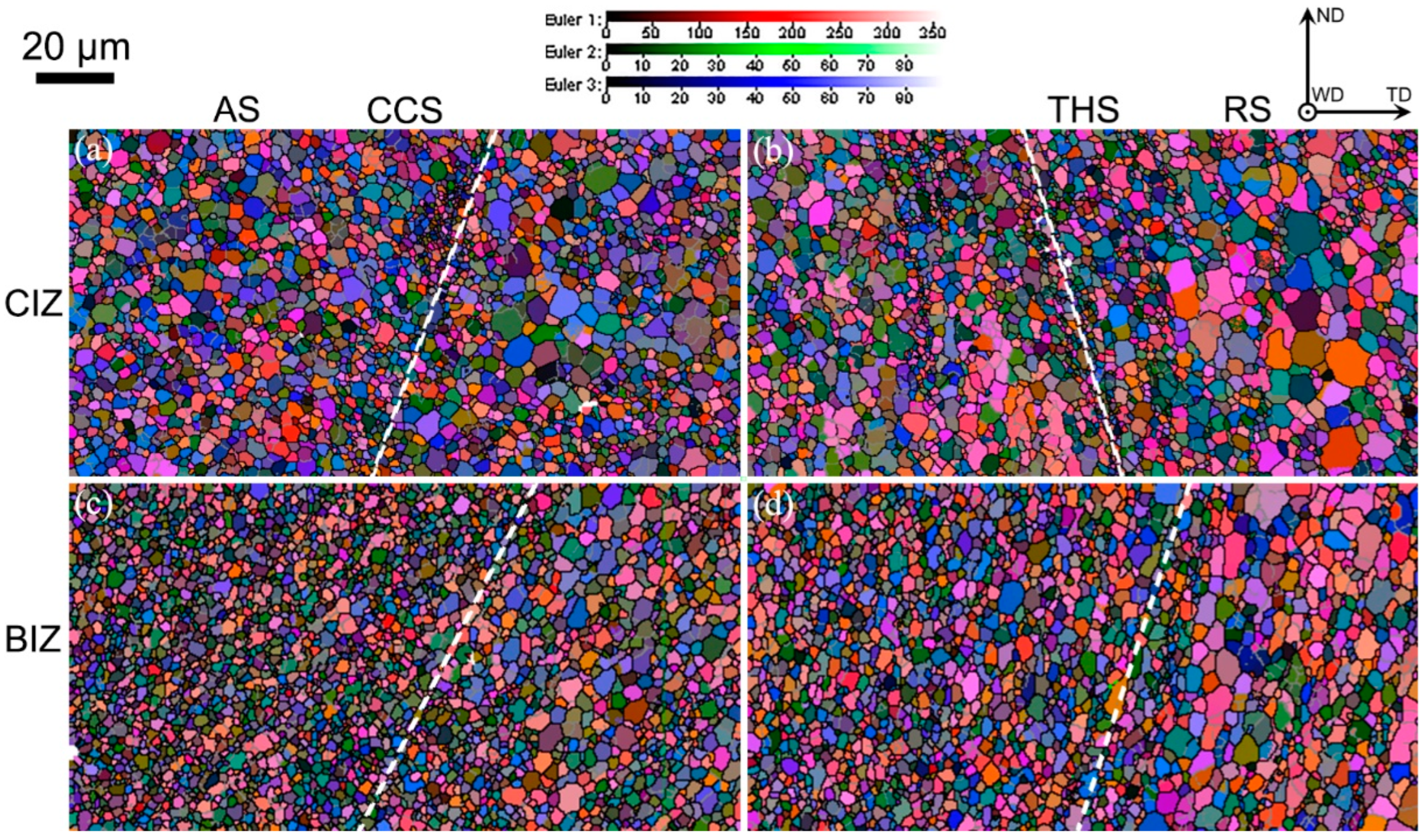
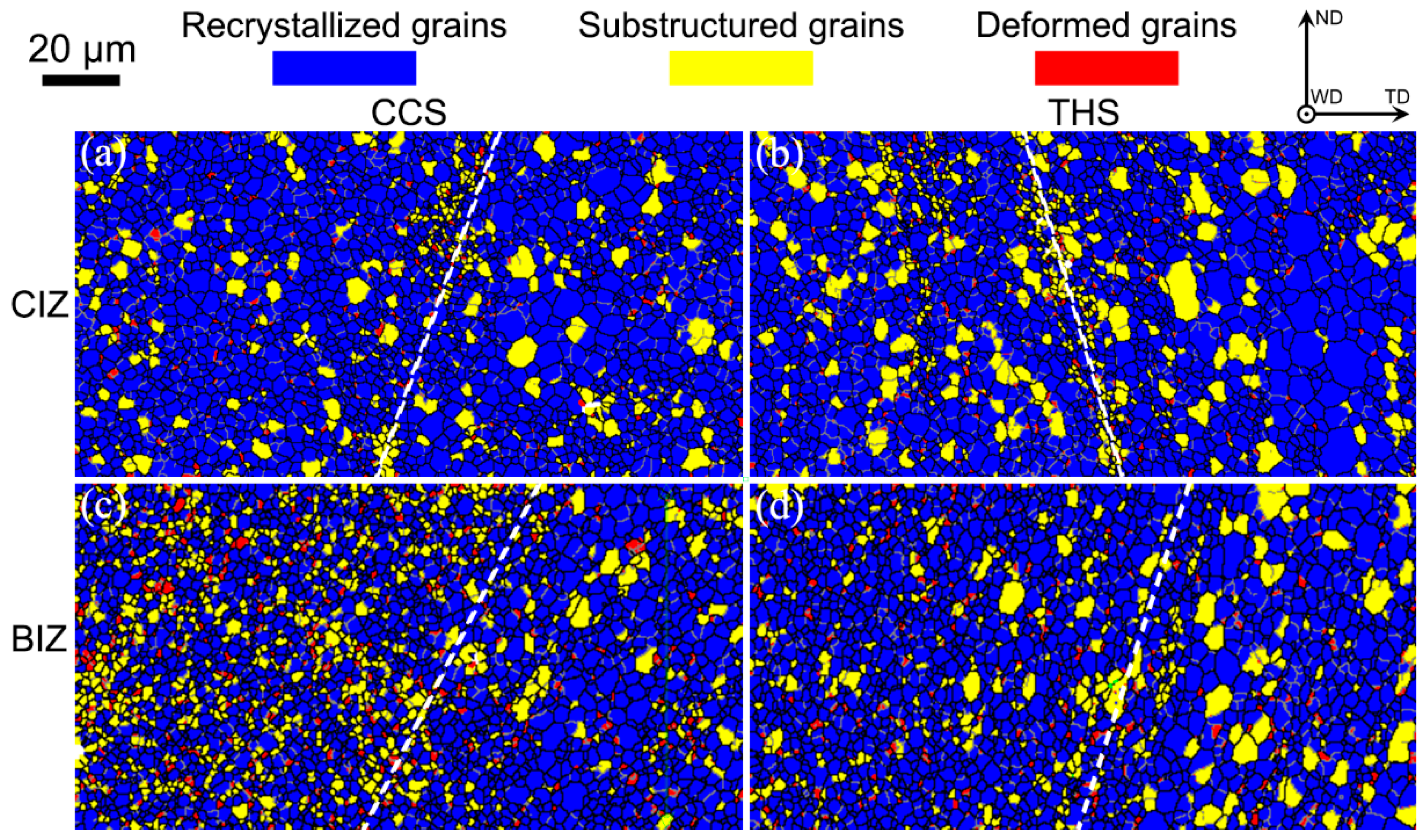
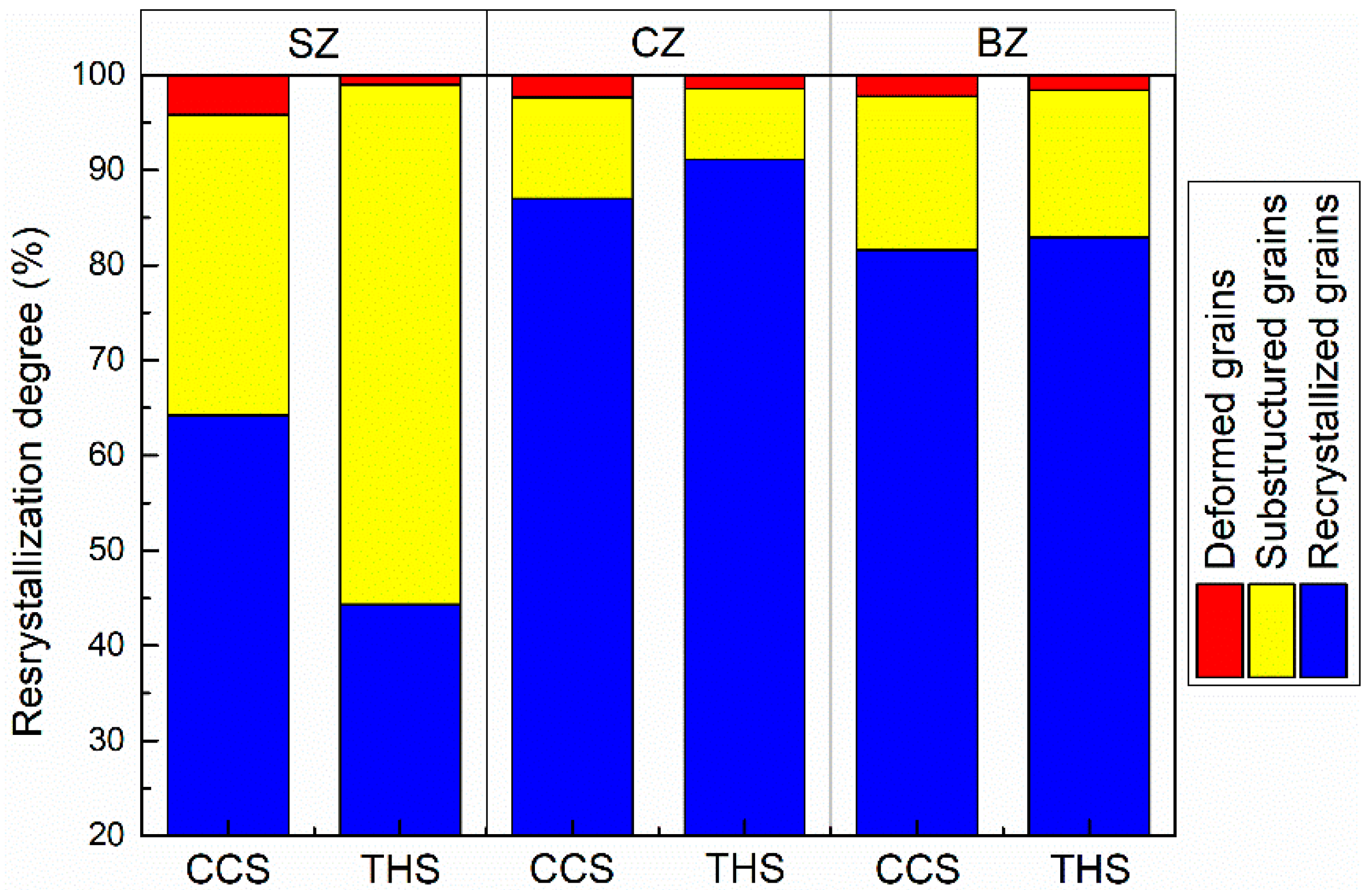
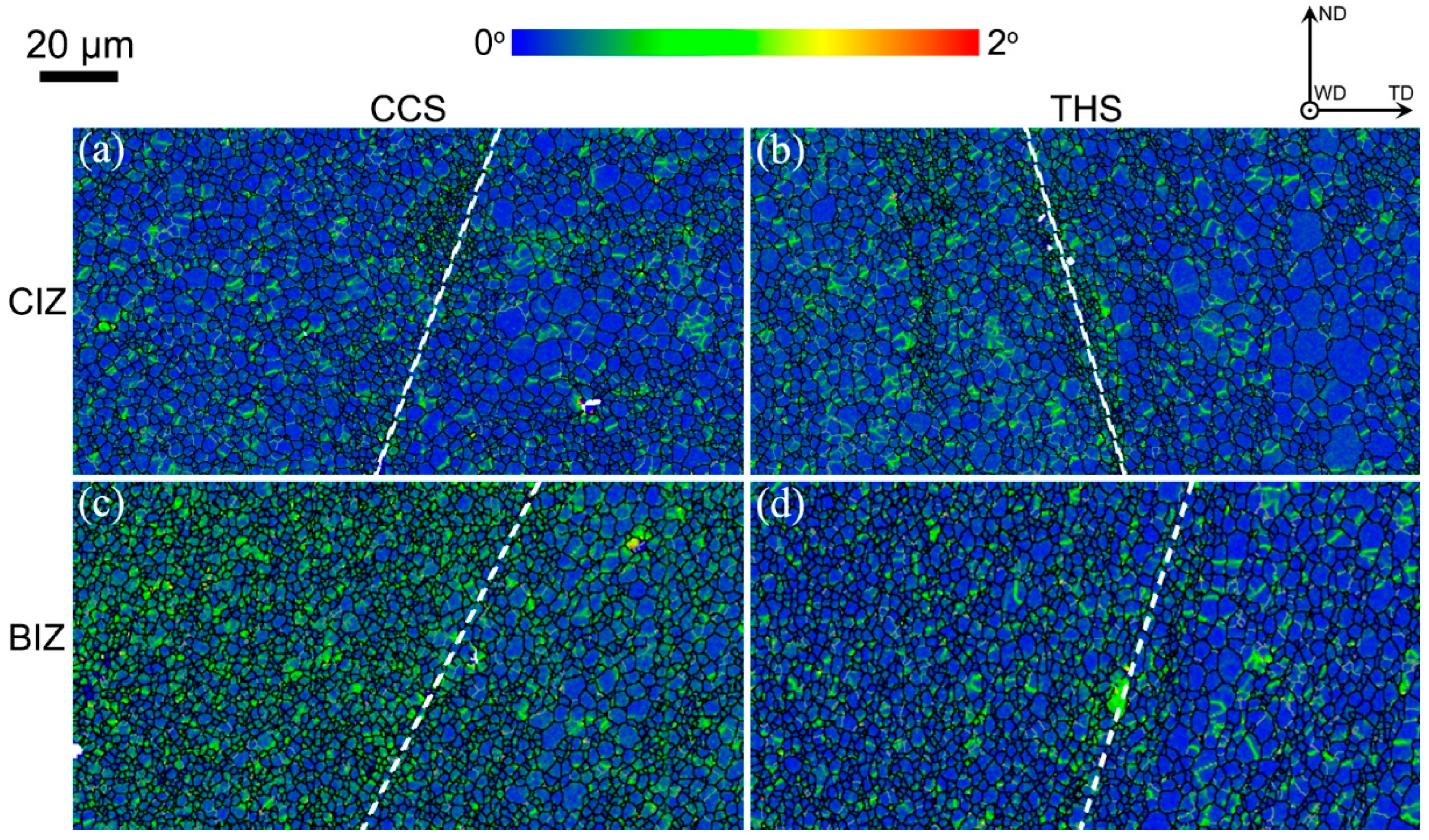

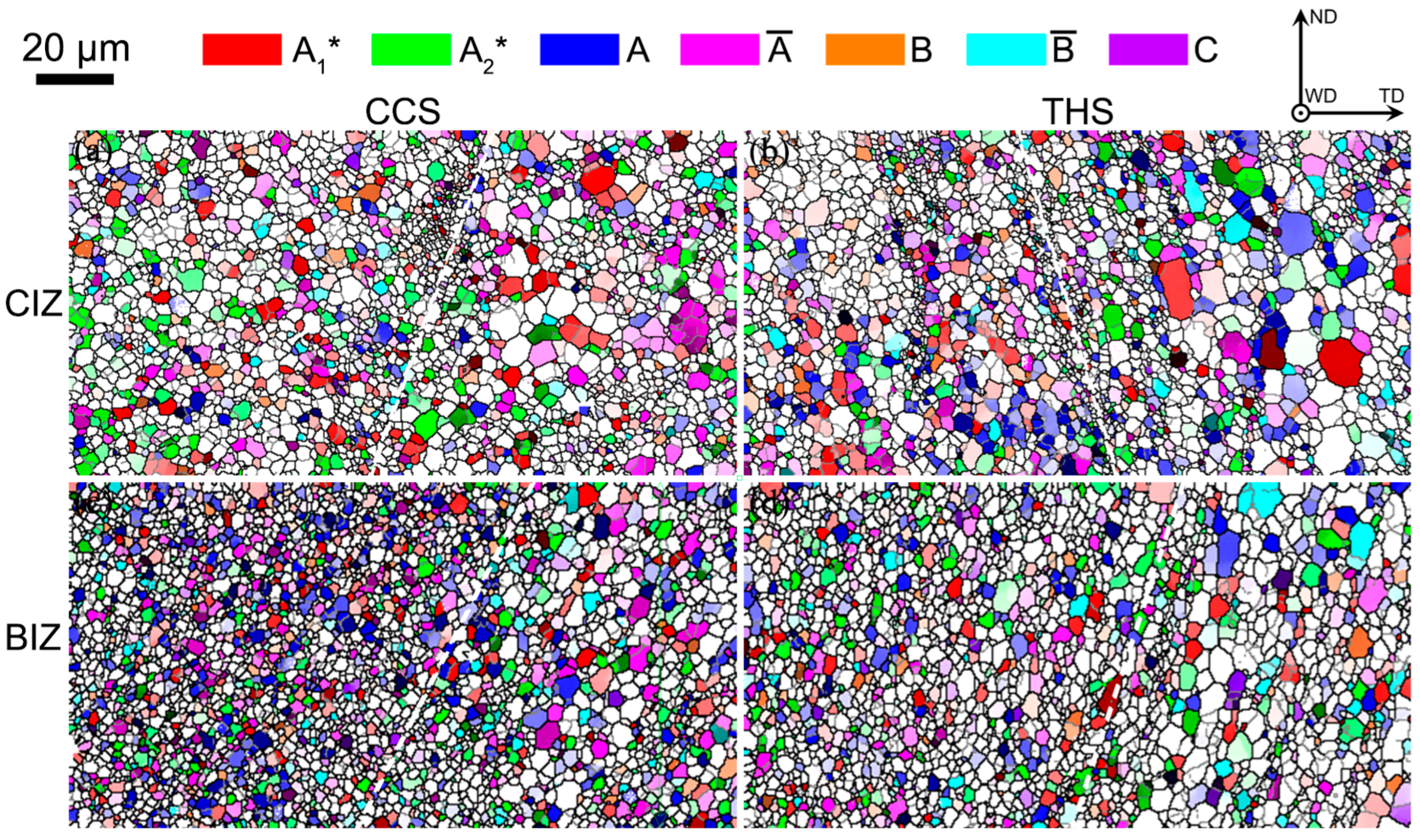
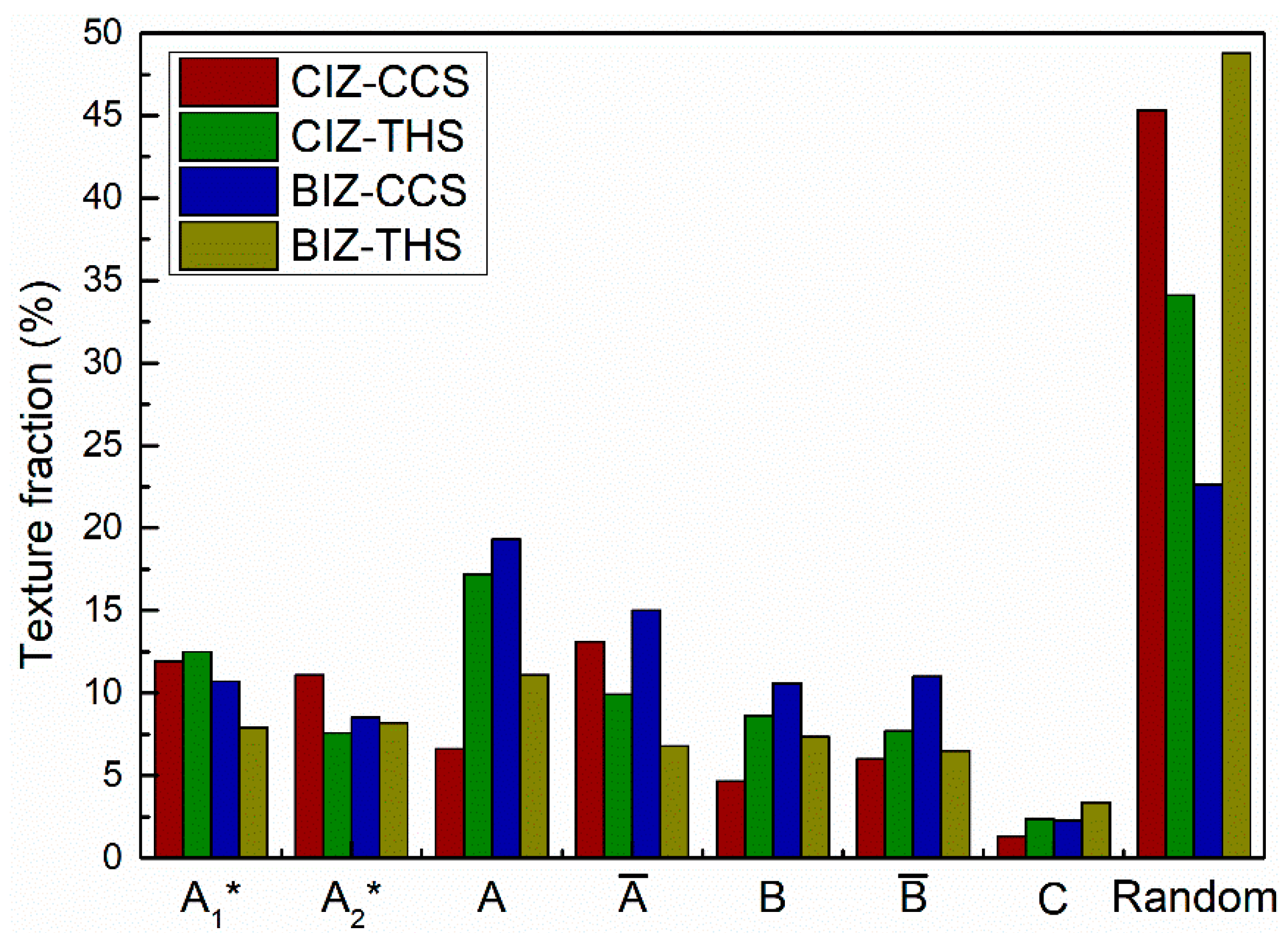
| BM | Al | Zn | Mg | Cu | Mn | Ti | Cr | Si | Fe | Yield Strength | Tensile Strength | Elongation |
|---|---|---|---|---|---|---|---|---|---|---|---|---|
| AA2024-T351 | Bal. | 0.03 | 1.4 | 4.5 | 0.6 | 0.02 | 0.01 | 0.05 | 0.17 | 360 MPa | 470 MPa | 20.3% |
| AA7075-T651 | Bal. | 5.8 | 2.4 | 1.7 | 0.04 | 0.03 | 0.2 | 0.05 | 0.19 | 476 MPa | 555 MPa | 11.4% |
| Tool | Shoulder Diameter | Pin-Tip Diameter | Pin Length |
|---|---|---|---|
| CCS | 15 | 3.76 | 5 |
| THS | 18 | 4.52 | 5 |
Disclaimer/Publisher’s Note: The statements, opinions and data contained in all publications are solely those of the individual author(s) and contributor(s) and not of MDPI and/or the editor(s). MDPI and/or the editor(s) disclaim responsibility for any injury to people or property resulting from any ideas, methods, instructions or products referred to in the content. |
© 2025 by the authors. Licensee MDPI, Basel, Switzerland. This article is an open access article distributed under the terms and conditions of the Creative Commons Attribution (CC BY) license (https://creativecommons.org/licenses/by/4.0/).
Share and Cite
Li, Q.; Zhang, C.; Sun, J.; Shou, H. Effect of Tool Shoulder Profile on Grain and Texture Development in the Weld Interface Zone of Friction-Stir-Welded Dissimilar AA2024/AA7075 Joints. Materials 2025, 18, 340. https://doi.org/10.3390/ma18020340
Li Q, Zhang C, Sun J, Shou H. Effect of Tool Shoulder Profile on Grain and Texture Development in the Weld Interface Zone of Friction-Stir-Welded Dissimilar AA2024/AA7075 Joints. Materials. 2025; 18(2):340. https://doi.org/10.3390/ma18020340
Chicago/Turabian StyleLi, Qi, Chenghang Zhang, Jianhong Sun, and Haoge Shou. 2025. "Effect of Tool Shoulder Profile on Grain and Texture Development in the Weld Interface Zone of Friction-Stir-Welded Dissimilar AA2024/AA7075 Joints" Materials 18, no. 2: 340. https://doi.org/10.3390/ma18020340
APA StyleLi, Q., Zhang, C., Sun, J., & Shou, H. (2025). Effect of Tool Shoulder Profile on Grain and Texture Development in the Weld Interface Zone of Friction-Stir-Welded Dissimilar AA2024/AA7075 Joints. Materials, 18(2), 340. https://doi.org/10.3390/ma18020340





